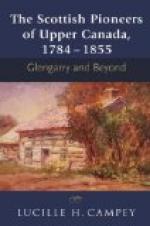“Her leisure hours from hunting had been employed in twisting the inner rind or bark of willows into small lines, like net twine, of which she had some hundred fathoms by her; with this she intended to make a fishing net as soon as the spring advanced. It is of the inner bark of willows, twisted in this manner, that the Dog-rib Indians make their fishing nets, and they are much preferable to those made by the Northern Indians.
“Five or six inches of an iron hoop, made into a knife, and the shank of an arrowhead of iron, which served her as an awl, were all the metals this poor woman had with her when she eloped, and with these implements she had made herself complete snowshoes, and several other useful articles.
“Her method of making a fire was equally singular and curious, having no other materials for that purpose than two hard sulphurous stones. These, by long friction and hard knocking, produced a few sparks, which at length communicated to some touchwood (a species of fungus which grew on decayed poplars); but as this method was attended with great trouble, and not always with success, she did not suffer her fire to go out all the winter....”
Hearne regained Prince of Wales’s Fort on Hudson Bay in June, 1772. Subsequently he was dispatched, in the year 1774, to found the first great inland trading station and fort of the Hudson’s Bay Company which was established at any considerable distance westward of Hudson Bay—the first step, in fact, which led to this chartered company becoming in time the ruler and colonizing agent of Alberta and British Columbia. Hearne chose for his station of “Cumberland House” a site at the entrance to Pine Island Lake on the lower Saskatchewan River.
In 1775 he became Governor of his old starting-point on Hudson Bay—Fort Prince of Wales. During the American war with France, the French admiral, La Perouse, made a daring excursion into Hudson Bay (1782), and summoned Hearne to surrender his fort. This he felt obliged to do, not deeming his small garrison strong enough to resist the French force.
Samuel Hearne returned to England in 1787, and died (probably in London) in 1792.
CHAPTER XI
Alexander Mackenzie’s Journeys
It has been already mentioned that the conquest of Canada by the British led to a great increase in travel for the development of the fur trade. Previously, under the French, permission was only granted to a few persons to penetrate into the interior to trade with the natives, commerce being regarded as a special privilege or monopoly to be sold or granted by the Crown. But after the British had completely assumed control, nothing was done to bar access to the interior. So long as the Catholic missionaries had been practically placed in charge of the Amerindians, and had served as buffers between them and unscrupulous traders, they—the Amerindians—had been




